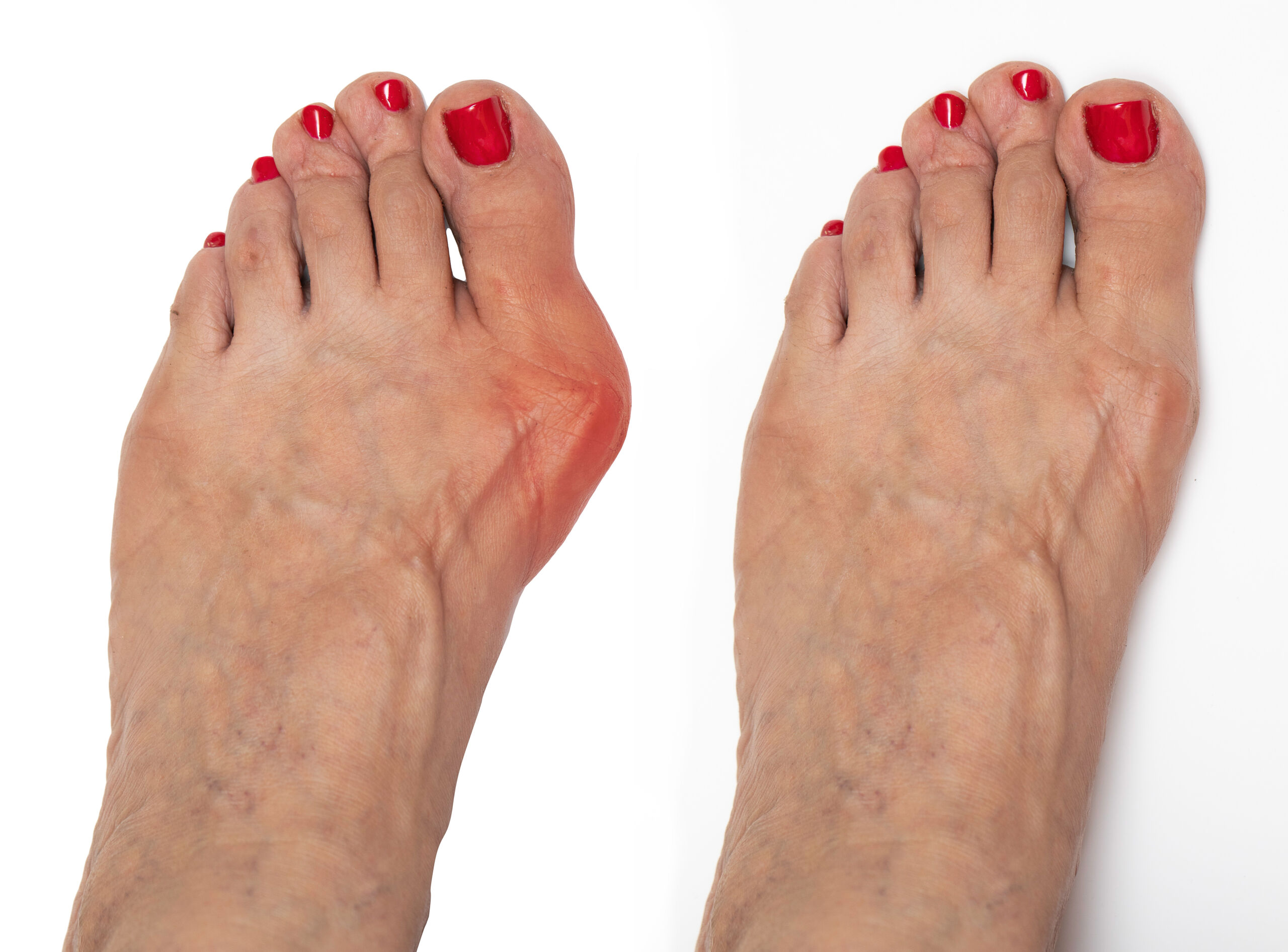Northern California Minimally Invasive Bunion Surgery
WHAT IS A BUNION?
“Bunion” (Latin for turnip) is the common name for hallux valgus, a condition that develops over time when foot alignment changes and the big toe begins to rotate and pull inward toward the smaller ones. The resulting bump of bone causes soft tissue damage and inflammation in the joint. The external bump caused by the internal bone displacement often rubs against the inside of the shoe, causing further pain and swelling and can lead to arthritis and other potential problems such as metatarsalgia and plantar plate tears.
WHAT CAUSES BUNIONS?
Bunions are usually caused by a combination of heredity and activity. If you have a family history of bunions, and you enjoy wearing pointy-toe stilettos, you may develop bunions. Jobs or sports that require extended time on the feet or performing a repetitive motion of the big toe joint may also contribute to develop bunions, for example ballerinas who dance en pointe. Additionally, other deformities can lead to bunion development such as flatfoot deformities.
CAN A BUNION GET BETTER ON ITS OWN?
It takes a long time for a bunion to develop, even when caused by trauma, but once a bunion develops it does not resolve on its own. Treated early there are things you can do to slow the process. Nonsurgical treatments include wearing soft shoes or shoes with a wide toe-box, and over the counter arch supports and inserts which can be purchased in orthopedic/physical therapy clinics, specialty footwear stores and pharmacies. You may also try using toe spacers and/or bunion pads. Bunion splints do not permanently correct bunion deformities. OTC analgesic/anti-inflammatory medications may lessen discomfort, but bunions do not heal on their own. The only method to realign the toe is through surgical correction. As the big toe continues to impinge on the smaller toes, other conditions, such as hammertoes and cross over toe deformities may also develop.
WHAT IS MINIMALLY INVASIVE BUNION SURGERY?
Minimally invasive bunion surgery is an innovative percutaneous bunionectomy that uses minimally invasive surgical techniques to correct bunion deformity through tiny incisions and tinier surgical instruments to access the inside of the metatarsal joint with less nerve and soft tissue damage. The surgeon assesses the joint or joints involved in real time, and makes the corrections indicated to correct the alignment of the foot. It has improved cosmesis, less pain, faster recovery and overall has higher patient satisfaction.

AM I A CANDIDATE FOR MINIMALLY INVASIVE BUNION SURGERY?
Most patients can be considered for minimally invasive bunion surgery, but it’s best determined with an in-person clinical exam and x-rays to make the final determination. Any surgery carries risk, and bunion surgery shouldn’t be done simply to correct appearance, but if nonsurgical treatments no longer offer pain relief and your bunion is beginning to limit your mobility and have a negative impact on the quality of your day-to-day life, surgery is the only way to stabilize the joints and correct your foot’s alignment.
Your surgeon may recommend minimally invasive bunion surgery for the following conditions:
· Significant foot pain that limits your activities of daily living
· Chronic inflammation and swelling of the big toe that does not improve with medication or rest
· Drifting of the big toe towards the second toe or overlapping of toes
· Toe stiffness: the inability to straighten or bend the big toe
· Failure to obtain pain relief with changes in footwear
· Unsuccessful treatment of pain with NSAIDs (nonsteroidal anti-inflammatory drugs)
· You are an active individual who desires a quick return to an active lifestyle
· You are not a candidate for open bunion surgery or wish to avoid open surgery
ADVANTAGES OF MINIMALLY INVASIVE BUNION SURGERY
Some of the benefits of minimally invasive bunion surgery include:
· Minimal post-surgical pain
· Less scarring
· Minimal swelling
· Faster recovery
· Small incisions
· Less damage to tissues
· Minimal joint stiffness
· Smaller Scars means less risk of infection, pain, improved cosmesis.
· Less Pain because fewer major tissue structures are disturbed in the process
· Faster Recovery
RISKS AND COMPLICATIONS
As with any surgery, minimally invasive bunion surgery may involve certain risks and complications. These may include the following:
· Pain
· Swelling
· Discomfort
· Infection
· Anesthetic complications
· Damage to nerves and blood vessels
· Bunion recurrence
· Over or under-correction
Minimally invasive bunion surgery has garnered a lot of attention and public enthusiasm, but you need to ensure it is performed by a highly trained surgeon, such as our board certified, fellowship trained orthopedic foot & ankle surgeons at Golden State Orthopedics & Spine.
Sources:
https://www.hss.edu/conditions_minimally-invasive-bunion-surgery.asp
https://stanfordhealthcare.org/stanford-health-care-now/2021/outpatient-MIS-bring-relief-foot-ankle-patients.html
https://pubmed.ncbi.nlm.nih.gov/30223949/
At Golden State Orthopedics & Spine we have surgeons who specialize in Foot & Ankle conditions and treatments for Minimally Invasive Bunion Surgery.
If you are experiencing pain or other symptoms, call us at 925-939-8585 to make your appointment or book it online
